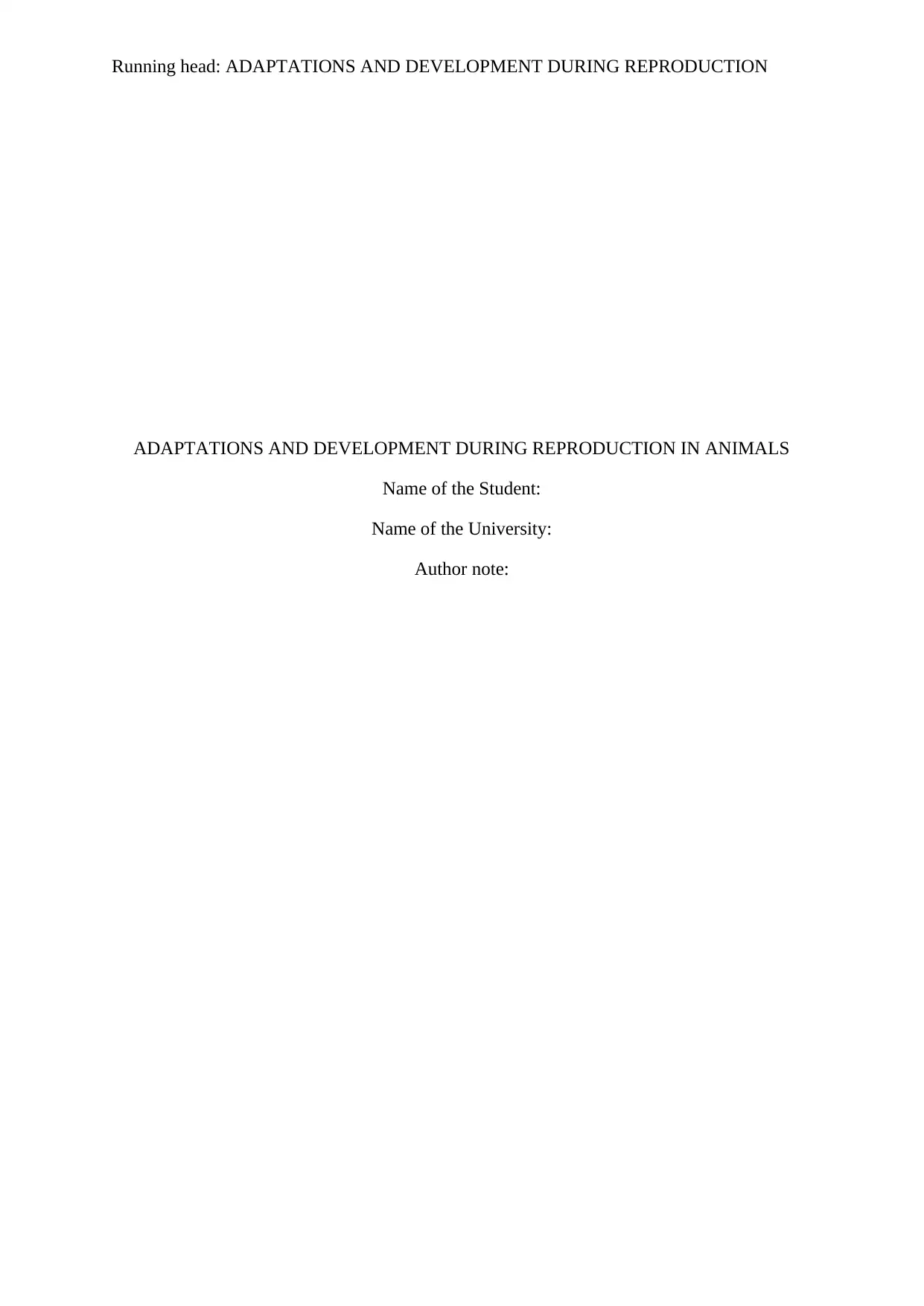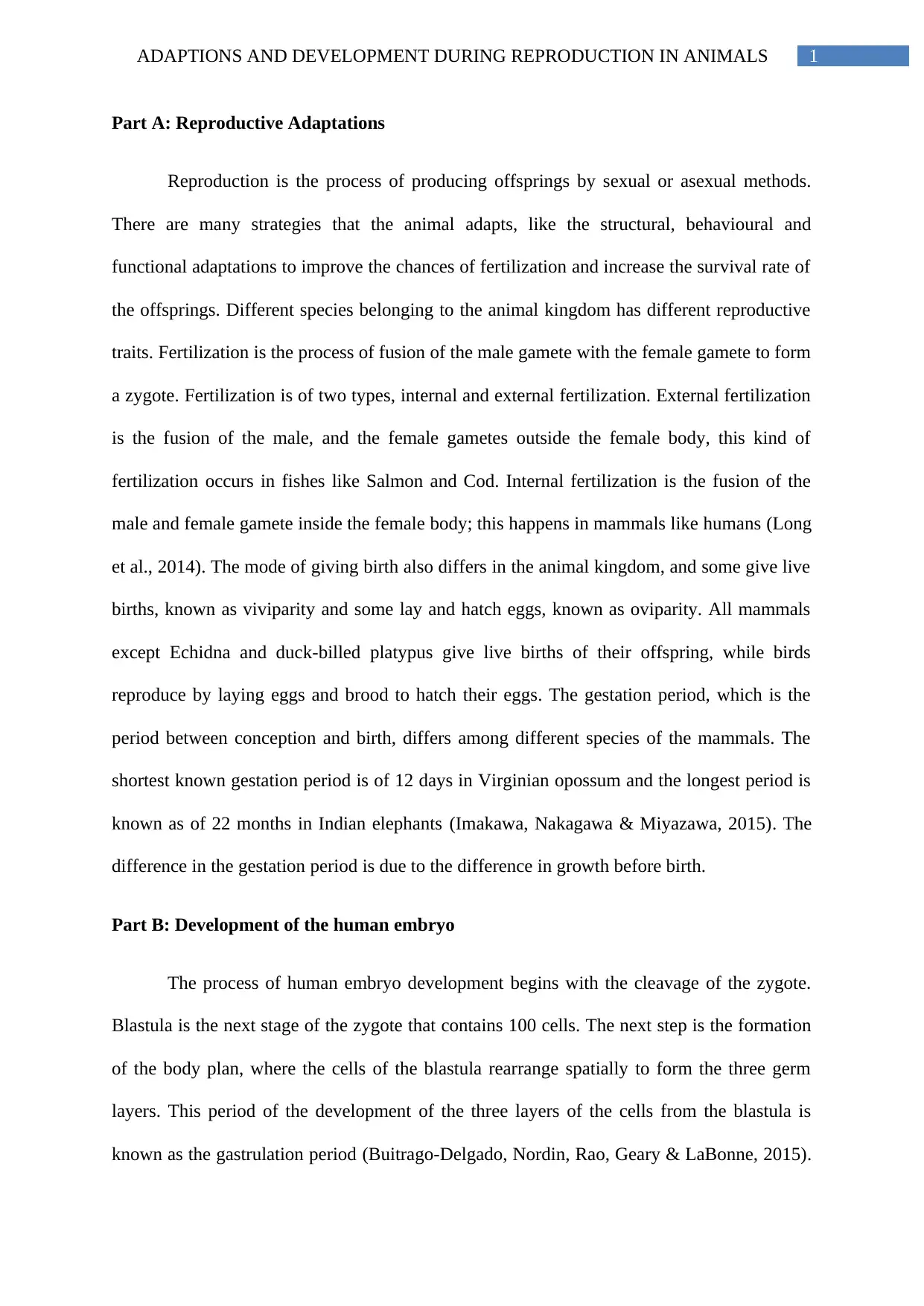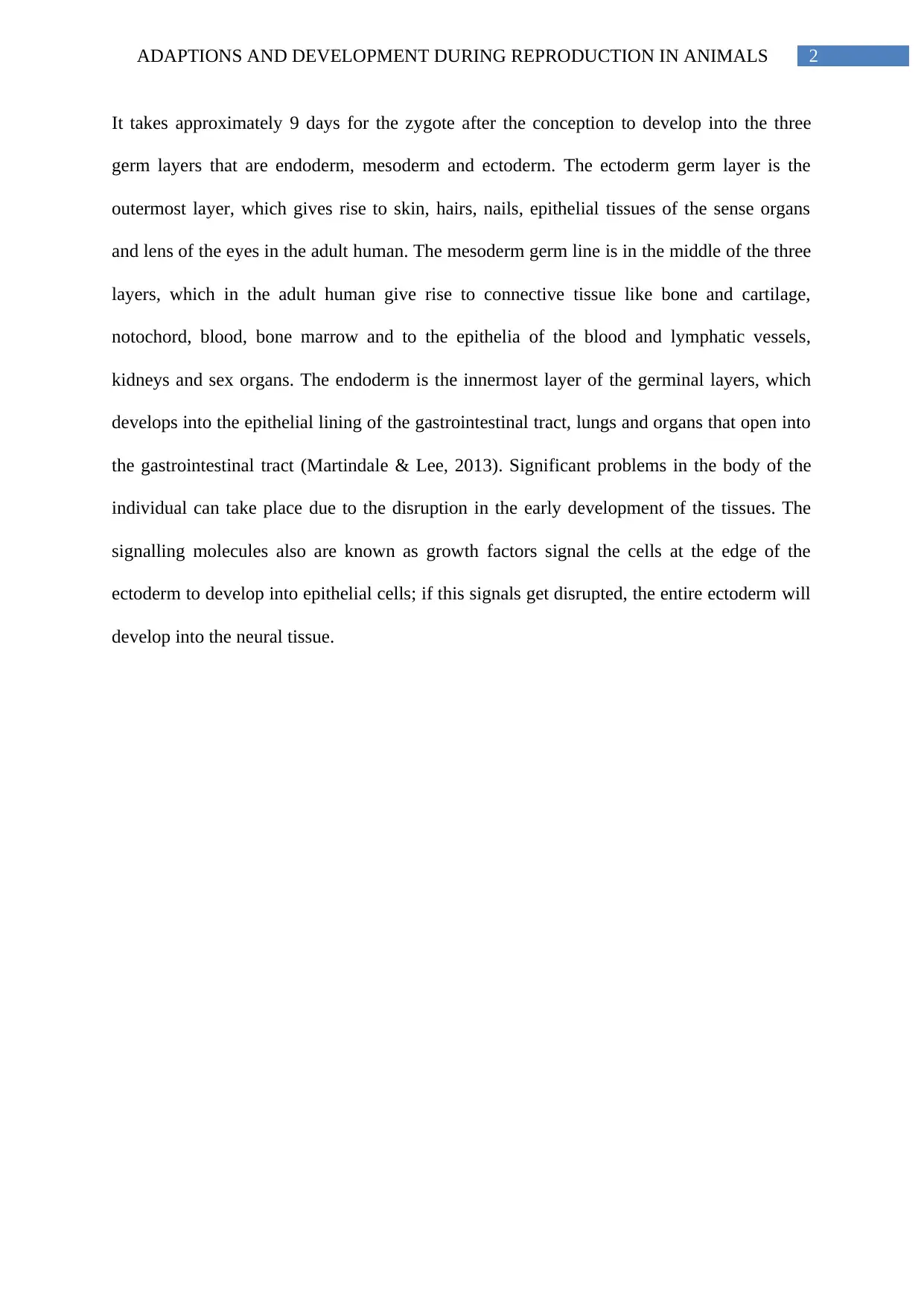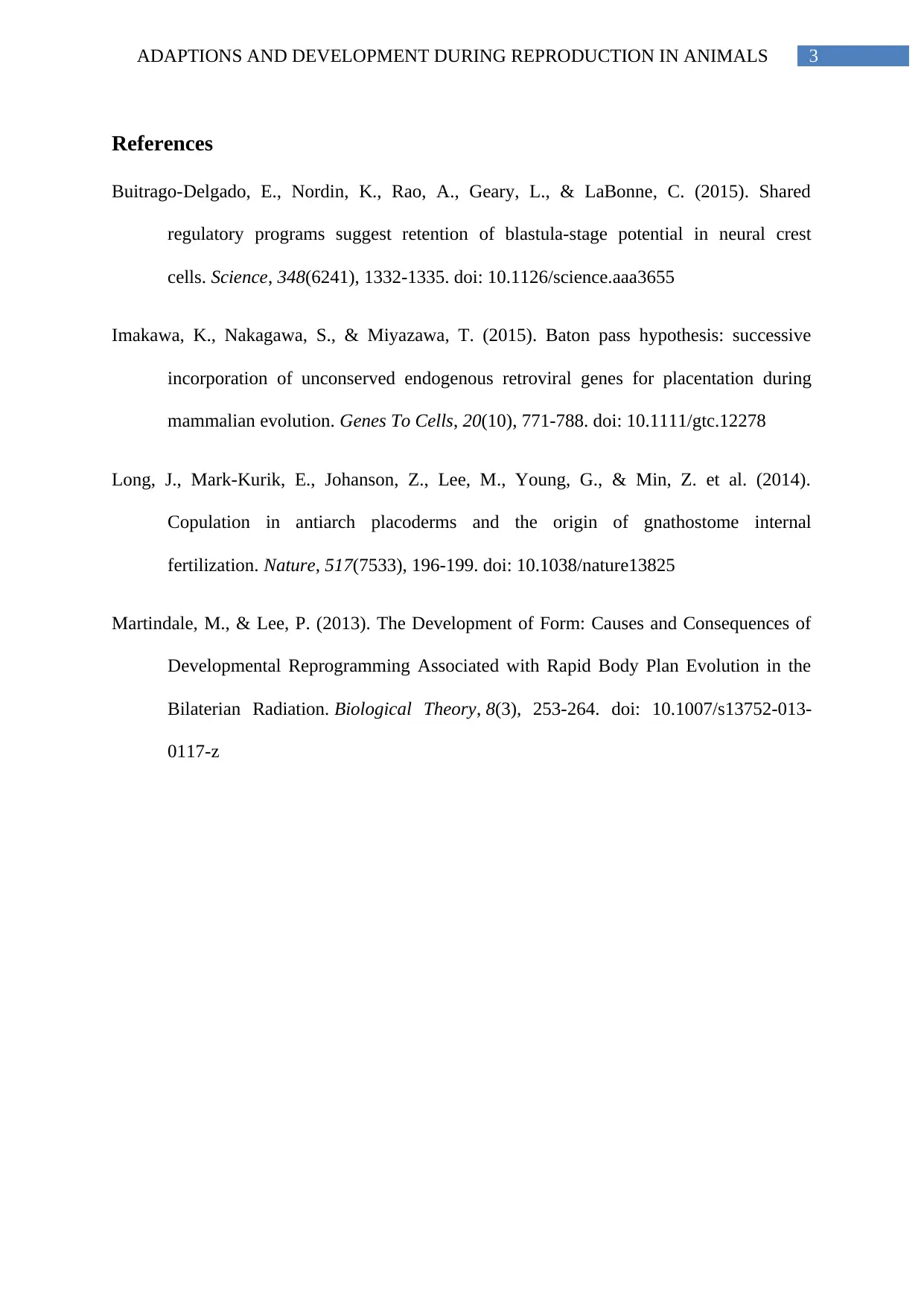Adaptations and Development During Reproduction in Animals
VerifiedAdded on 2023/04/25
|4
|839
|283
AI Summary
This article discusses the reproductive adaptations and development during reproduction in animals. It also covers the development of the human embryo and the three germ layers.
Contribute Materials
Your contribution can guide someone’s learning journey. Share your
documents today.

Running head: ADAPTATIONS AND DEVELOPMENT DURING REPRODUCTION
ADAPTATIONS AND DEVELOPMENT DURING REPRODUCTION IN ANIMALS
Name of the Student:
Name of the University:
Author note:
ADAPTATIONS AND DEVELOPMENT DURING REPRODUCTION IN ANIMALS
Name of the Student:
Name of the University:
Author note:
Secure Best Marks with AI Grader
Need help grading? Try our AI Grader for instant feedback on your assignments.

1ADAPTIONS AND DEVELOPMENT DURING REPRODUCTION IN ANIMALS
Part A: Reproductive Adaptations
Reproduction is the process of producing offsprings by sexual or asexual methods.
There are many strategies that the animal adapts, like the structural, behavioural and
functional adaptations to improve the chances of fertilization and increase the survival rate of
the offsprings. Different species belonging to the animal kingdom has different reproductive
traits. Fertilization is the process of fusion of the male gamete with the female gamete to form
a zygote. Fertilization is of two types, internal and external fertilization. External fertilization
is the fusion of the male, and the female gametes outside the female body, this kind of
fertilization occurs in fishes like Salmon and Cod. Internal fertilization is the fusion of the
male and female gamete inside the female body; this happens in mammals like humans (Long
et al., 2014). The mode of giving birth also differs in the animal kingdom, and some give live
births, known as viviparity and some lay and hatch eggs, known as oviparity. All mammals
except Echidna and duck-billed platypus give live births of their offspring, while birds
reproduce by laying eggs and brood to hatch their eggs. The gestation period, which is the
period between conception and birth, differs among different species of the mammals. The
shortest known gestation period is of 12 days in Virginian opossum and the longest period is
known as of 22 months in Indian elephants (Imakawa, Nakagawa & Miyazawa, 2015). The
difference in the gestation period is due to the difference in growth before birth.
Part B: Development of the human embryo
The process of human embryo development begins with the cleavage of the zygote.
Blastula is the next stage of the zygote that contains 100 cells. The next step is the formation
of the body plan, where the cells of the blastula rearrange spatially to form the three germ
layers. This period of the development of the three layers of the cells from the blastula is
known as the gastrulation period (Buitrago-Delgado, Nordin, Rao, Geary & LaBonne, 2015).
Part A: Reproductive Adaptations
Reproduction is the process of producing offsprings by sexual or asexual methods.
There are many strategies that the animal adapts, like the structural, behavioural and
functional adaptations to improve the chances of fertilization and increase the survival rate of
the offsprings. Different species belonging to the animal kingdom has different reproductive
traits. Fertilization is the process of fusion of the male gamete with the female gamete to form
a zygote. Fertilization is of two types, internal and external fertilization. External fertilization
is the fusion of the male, and the female gametes outside the female body, this kind of
fertilization occurs in fishes like Salmon and Cod. Internal fertilization is the fusion of the
male and female gamete inside the female body; this happens in mammals like humans (Long
et al., 2014). The mode of giving birth also differs in the animal kingdom, and some give live
births, known as viviparity and some lay and hatch eggs, known as oviparity. All mammals
except Echidna and duck-billed platypus give live births of their offspring, while birds
reproduce by laying eggs and brood to hatch their eggs. The gestation period, which is the
period between conception and birth, differs among different species of the mammals. The
shortest known gestation period is of 12 days in Virginian opossum and the longest period is
known as of 22 months in Indian elephants (Imakawa, Nakagawa & Miyazawa, 2015). The
difference in the gestation period is due to the difference in growth before birth.
Part B: Development of the human embryo
The process of human embryo development begins with the cleavage of the zygote.
Blastula is the next stage of the zygote that contains 100 cells. The next step is the formation
of the body plan, where the cells of the blastula rearrange spatially to form the three germ
layers. This period of the development of the three layers of the cells from the blastula is
known as the gastrulation period (Buitrago-Delgado, Nordin, Rao, Geary & LaBonne, 2015).

2ADAPTIONS AND DEVELOPMENT DURING REPRODUCTION IN ANIMALS
It takes approximately 9 days for the zygote after the conception to develop into the three
germ layers that are endoderm, mesoderm and ectoderm. The ectoderm germ layer is the
outermost layer, which gives rise to skin, hairs, nails, epithelial tissues of the sense organs
and lens of the eyes in the adult human. The mesoderm germ line is in the middle of the three
layers, which in the adult human give rise to connective tissue like bone and cartilage,
notochord, blood, bone marrow and to the epithelia of the blood and lymphatic vessels,
kidneys and sex organs. The endoderm is the innermost layer of the germinal layers, which
develops into the epithelial lining of the gastrointestinal tract, lungs and organs that open into
the gastrointestinal tract (Martindale & Lee, 2013). Significant problems in the body of the
individual can take place due to the disruption in the early development of the tissues. The
signalling molecules also are known as growth factors signal the cells at the edge of the
ectoderm to develop into epithelial cells; if this signals get disrupted, the entire ectoderm will
develop into the neural tissue.
It takes approximately 9 days for the zygote after the conception to develop into the three
germ layers that are endoderm, mesoderm and ectoderm. The ectoderm germ layer is the
outermost layer, which gives rise to skin, hairs, nails, epithelial tissues of the sense organs
and lens of the eyes in the adult human. The mesoderm germ line is in the middle of the three
layers, which in the adult human give rise to connective tissue like bone and cartilage,
notochord, blood, bone marrow and to the epithelia of the blood and lymphatic vessels,
kidneys and sex organs. The endoderm is the innermost layer of the germinal layers, which
develops into the epithelial lining of the gastrointestinal tract, lungs and organs that open into
the gastrointestinal tract (Martindale & Lee, 2013). Significant problems in the body of the
individual can take place due to the disruption in the early development of the tissues. The
signalling molecules also are known as growth factors signal the cells at the edge of the
ectoderm to develop into epithelial cells; if this signals get disrupted, the entire ectoderm will
develop into the neural tissue.

3ADAPTIONS AND DEVELOPMENT DURING REPRODUCTION IN ANIMALS
References
Buitrago-Delgado, E., Nordin, K., Rao, A., Geary, L., & LaBonne, C. (2015). Shared
regulatory programs suggest retention of blastula-stage potential in neural crest
cells. Science, 348(6241), 1332-1335. doi: 10.1126/science.aaa3655
Imakawa, K., Nakagawa, S., & Miyazawa, T. (2015). Baton pass hypothesis: successive
incorporation of unconserved endogenous retroviral genes for placentation during
mammalian evolution. Genes To Cells, 20(10), 771-788. doi: 10.1111/gtc.12278
Long, J., Mark-Kurik, E., Johanson, Z., Lee, M., Young, G., & Min, Z. et al. (2014).
Copulation in antiarch placoderms and the origin of gnathostome internal
fertilization. Nature, 517(7533), 196-199. doi: 10.1038/nature13825
Martindale, M., & Lee, P. (2013). The Development of Form: Causes and Consequences of
Developmental Reprogramming Associated with Rapid Body Plan Evolution in the
Bilaterian Radiation. Biological Theory, 8(3), 253-264. doi: 10.1007/s13752-013-
0117-z
References
Buitrago-Delgado, E., Nordin, K., Rao, A., Geary, L., & LaBonne, C. (2015). Shared
regulatory programs suggest retention of blastula-stage potential in neural crest
cells. Science, 348(6241), 1332-1335. doi: 10.1126/science.aaa3655
Imakawa, K., Nakagawa, S., & Miyazawa, T. (2015). Baton pass hypothesis: successive
incorporation of unconserved endogenous retroviral genes for placentation during
mammalian evolution. Genes To Cells, 20(10), 771-788. doi: 10.1111/gtc.12278
Long, J., Mark-Kurik, E., Johanson, Z., Lee, M., Young, G., & Min, Z. et al. (2014).
Copulation in antiarch placoderms and the origin of gnathostome internal
fertilization. Nature, 517(7533), 196-199. doi: 10.1038/nature13825
Martindale, M., & Lee, P. (2013). The Development of Form: Causes and Consequences of
Developmental Reprogramming Associated with Rapid Body Plan Evolution in the
Bilaterian Radiation. Biological Theory, 8(3), 253-264. doi: 10.1007/s13752-013-
0117-z
1 out of 4
Your All-in-One AI-Powered Toolkit for Academic Success.
+13062052269
info@desklib.com
Available 24*7 on WhatsApp / Email
![[object Object]](/_next/static/media/star-bottom.7253800d.svg)
Unlock your academic potential
© 2024 | Zucol Services PVT LTD | All rights reserved.

